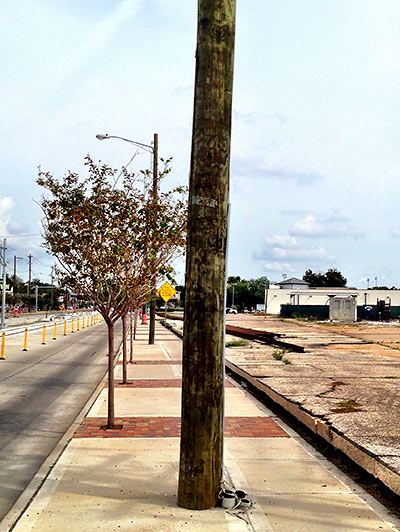
Courtesy of a reader wielding a camera along Harrisburg Blvd., here’s a tour of a few standout elements you can expect to encounter in a stroll along the path of Houston’s new East End light-rail line, now that sidewalk coordination work between CenterPoint Energy, Metro, and the Greater East End Management District has been completed.
“Most of the poles,” the reader reports, “are now in the center of the sidewalk leaving 24 inches to squeeze by on either side.” Or maybe a bit more:
***
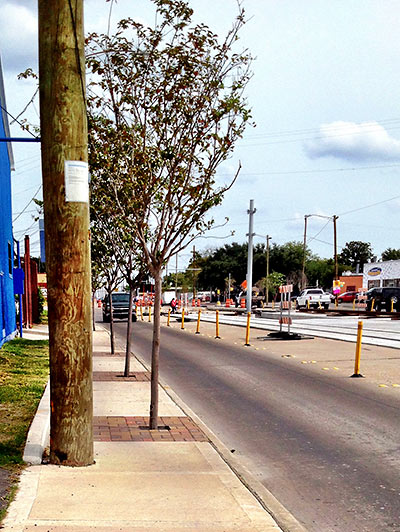
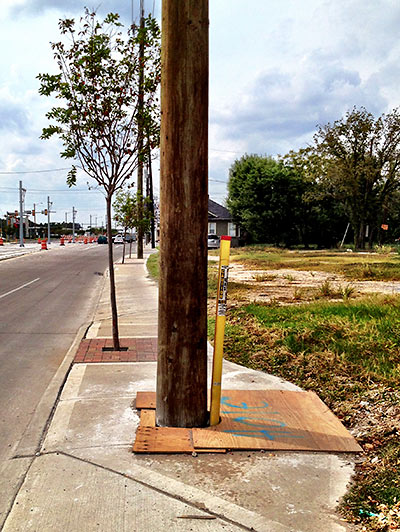
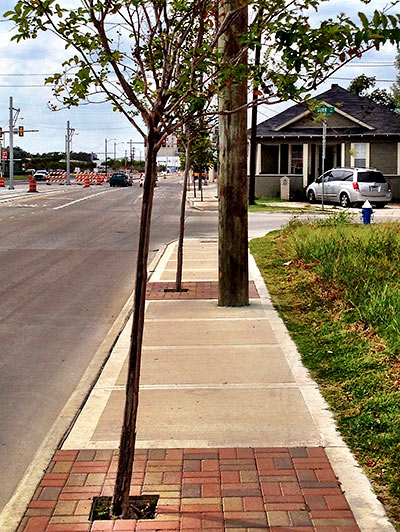
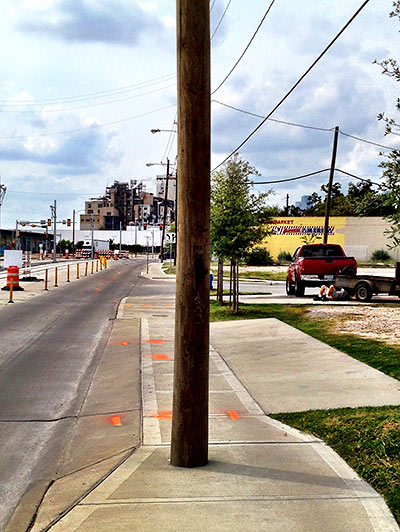
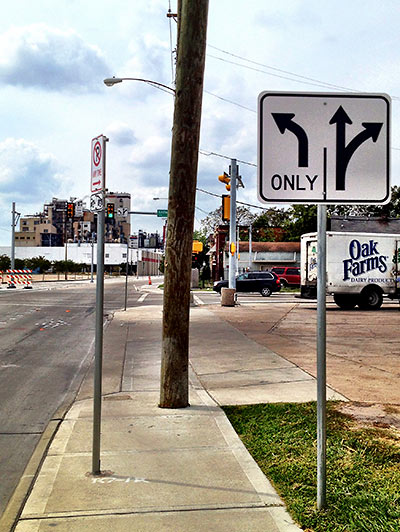
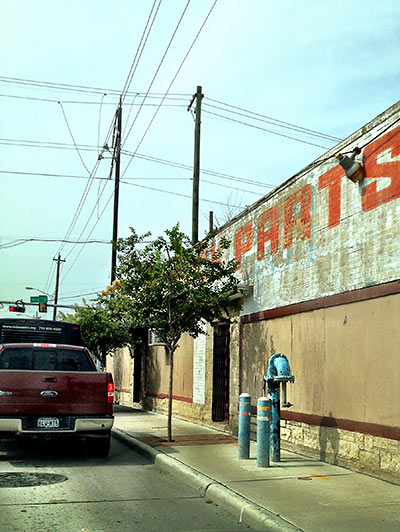
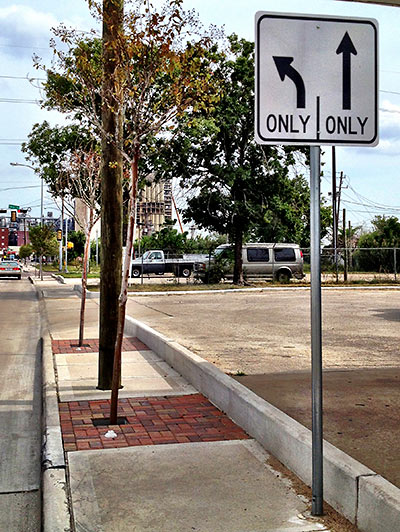
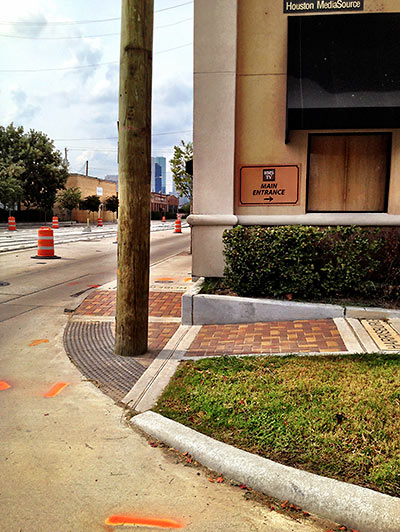
“The sad thing about the poles,” the tipster claims, “is that they prevent awnings and sidewalk signage on the buildings that you would typically see in walkable urban centers or transit oriented developments. I guess no one thought about that since the utility lines were already buried on Main Street before light rail was constructed.”
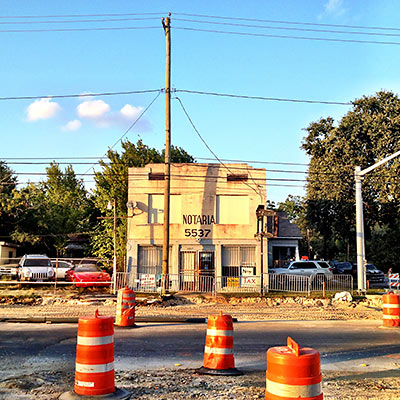
Photos: Swamplot inbox


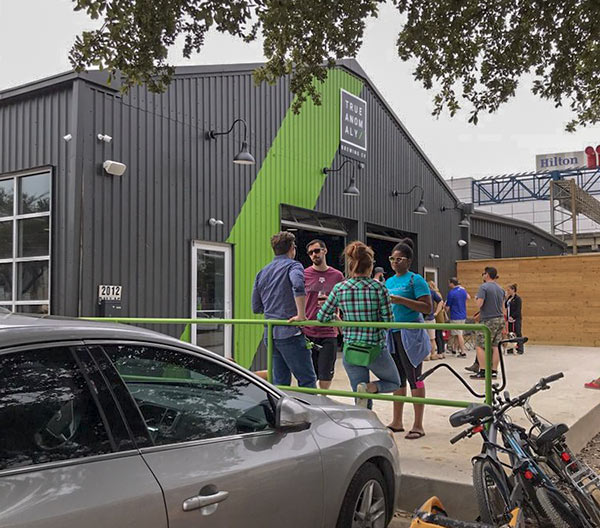
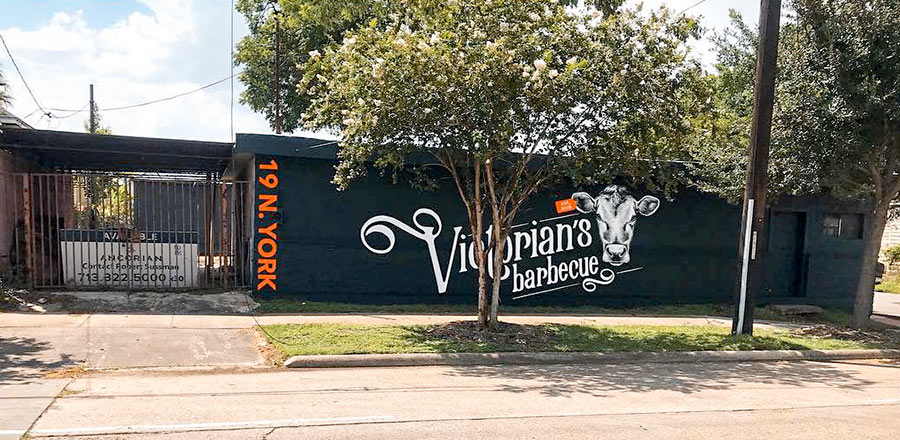

I haven’t seen that many poles since… nevermind…
I can see how this would totally stump people who prefer to walk instead of drive.
“… now that sidewalk coordination work between CenterPoint Energy, Metro, and the Greater East End Management District has been completed.”
.
Houston:
It’s Worth It!Who Gives a Sh*t!? (TM)Ridiculous. And, the trees are going to cause the sidewalks to buckle as the roots grow. What idiot planned this?
That must be fun to navigate on a wheelchair.
I especially like the pole right in the middle of the handicap sidewalk slope.
And add to that no bike line… so, no way to ride on the sidewalk and no room to ride on the street… typical City of Houston project that detracts as much value as it adds.
Looks like the makings of some Americans with Disabilities Act lawsuits.
looks like there are a whole bunch of things in the middle of the sidewalks in those pictures. If you look up from your texting while walking, I’m sure you’ll be fine.
My compliments to the photographer on the fifth pic after the jump (the one with the Oak Farms truck). That’s urban poetry there.
How can TAS let Centerpoint get away with that? How is a wheel chair supposed to navigate around these poles!?
Most Houston sidewalks are mere decorative elements without a function, so why the fuss?
Only in Houston.
What a mess. I would like to know the story of why no one used this opportunity to bury these eyesores. I guess they don’t remember how the above ground power lines fared during Ike.
Yeah, why can’t we bury these things? I realize that this isn’t the most walkable city in America, but this will do nothing to encourage people to take up pedestrian habits (not to mention wheelchairs, strollers, bikes). I just don’t get it.
Aren’t all sidewalks in Houston like this (i.e., full of obstructions like street signs and telephone poles and apparently design without regard to actual pedestrians, much less people in wheelchairs)? Why should Harrisburg be any different?
commonsense, at least pedestrians don’t require signs reminding them not to hurtle forward into oncoming pedestrians as cars do vis-Ã -vis other cars at Every Single Intersection, or multiple signs explaining that their eyes do not deceive, the sidewalk is curving; or that in case of rain, water may be on the sidewalk, or a sign reminding them that there’s a stop sign ahead, there where you see that stop sign; or signs that say “Car Crossing” with a picture of a car to familiarize them with that.
Sidewalks are only for people who’s car ran out of gas and they need a way to walk to the nearest gas station.
It’s Houston, sidewalk ROW belongs to utilities, not pedestrians.
as to the question about where bicycles should ride, there’s a HUGE unused space between the car lane and track, and if they don’t mark that for bicycle use I’d be a little surprised, but I won’t be surprised at all if cycles end up riding there (whether marked for use or not).
Robert, I think the point people are making is “if you’re going to spend millions to rebuild the sidewalks on a big street project, maybe it would be a good idea to make them ADA compliant.”
I like the pic (#4 after jump) with the legs sticking out from under the truck.
We have lots more pictures, several of us complaining about these sidewalks for months. Everyone blames everyone else. In the meantime the East End has to put up with this what is supposed to be a walkable transit corridor. What a joke! Metro finally agreed to look at this – however no cost to them. Residents spending hours trying to come up with solutions.
Robert, I think the point people are making is “if you’re going to spend millions to rebuild the sidewalks on a big street project, maybe it would be a good idea to make them ADA compliant.â€
what in the world makes you think that would happen. we’re lucky when we get sidewalks at all.
The bicycle issue was solved years ago when they paved a dedicated hike-and-bike trail on an abandoned railroad ROW just one block to the north of Harrisburg.
But yeah, it was pretty stupid to redo everything and still half-ass it. All hail the “new” METRO (same as the old METRO).
As if the poles aren’t bad enough, why does Metro spend money on planting trees directly under said power lines. Give those trees 5 years and Centerpoint contractors will come along with their chipper trucks and saw the tops of those trees right off!
But DarbyMom, the trees are planted with brick pavers around them, not concrete, so as the trunks and roots grow, the pavers can be adjusted around them. That’s good planning, however, they failed to look up when they planted those trees.
These aren’t sidewalks! They are weed growth inhibitors for Metro. They are also effective strategies for keeping bicycles and pedestrians in their place on the streets where they belong.
It’s stupid, the lines should have been buried. However, this shouldn’t be METRO’s responsibility. The owner of the lines should have worked with METRO to bury the lines during construction.
If I didn’t know better I’d think these images were photoshopped. Unfortunately, I’m from Houston and I do know better.
Yeah, this isn’t photoshopped. I live right off Harrisburg and was a little shocked the poles were left and not buried. It makes the whole project seem unfinished. But I guess at least we’ll have a rail line. Isn’t that the typical logic when it comes to addressing Houston’s common medicority and disappointments?
This is all over the city and it really looks like crap. Way to drive away higher income folk. Keep them in the city and property tax goes up…..more money for the city.
Can’t wait to see how messed up W. Dallas is after the highrise and apartments are completed next to Waugh. Already have powerlines on both sides of the road, for whatever reason.
We are in “Space City” in the second decade of the 21st century. Why do we still have wooden poles holding wires above ground every X# of meters?
Here’s some irony: it’s OK for the city to build sidewalks unpassable to the handicapped, yet they require that new homes in the inner loop build 4′ handicap accessible sidewalks – even where there are no neighboring sidewalks. I live in Boulevard Oaks and the city’s sidewalk requirement is slowly – house by house – taking out the trees that line our historic streets. Whenever a new construction house is built, the sidewalk goes in… and six months later, the trees are dying.
Why do we still have power poles? Because no one wants to cough up the billion plus dollars it takes to bury them all over the city.
In my neighborhood, we have two sets of poles. A tall set that carry the power lines, and some shorter poles that carry the phone and cable tv wires. I don’t know that they could easily be buried, given there’s a gas main and a sewer main back there.
The least they could have done was run a good portion of the power lines down the center of the roadway above the rail lines. There are many streets in Clear Lake that are arranged that way. It may not be the best plan, but at least it moves the poles off of the sidewalks.
THIS is what makes Houston a world class city!!!
Oy vey.
Shhhh! That guy is taking a siesta under the trailer.
As noted in #33, burying power is extremely costly and difficult. If you though light rail was already expensive, just consider what it would have been if undergrounding was required.
Also, as you are assigning blame, please know that the City government had the power, through its consent agreement, to require wider sidewalks. Put another foot or two on a sidewalk and suddenly an intrusive fixture, like a power pole, become less of an obstacle. However, elected officials at that time were freaked out about right-of-way takes. Also, the mayoral administration at that time decided that the City should not burden METRO with more costs, a position with which of course METRO heartily agreed. There was no other funding mechanism (like the recently created East End TIRZ) to fill the cost gap. There were those of us who tried very hard to express our concern, but it was decided otherwise. So when you are dismayed at the photos above, rest assured that when the City officials made their choice, they knew full well that we would end up with those results.
So, I remember when the scoping meetings were being held at the Marbella Ballroom there was an emphasis on pedestrian improvements along Harrisburg and also branching out into the neighborhoods in order to funnel pedestrians to light rail, thereby enabling its success.
It sounds like the City paid a lot of money for sage advice from both professionals and citizens, then deliberately ignored it. (Was this before or after they committed tens of millions of dollars toward an underpass at Harrisburg?)
NOW, we have a TIRZ. And perhaps that explains why the Greater East End Management District has begun discussing ideas for a streetcar line through an area predominated by warehouses. They have revenue and feel burdened to contrive a purpose. Anything but vitally important yet unsexy pedestrian improvements, I suppose. Pyrrhic victories are the only sort that matter, don’t you know.
Seriously. Which dumbf*ck was responsible for this – they should be fired.
Posts 38 & 39, very informative (and disheartening).
Just to add, I think a problem with burying power lines is our soggy soil. Ask an electrician – if you put wire in a pipe, and put that pipe underground, water gets in the pipe. Sooner or later, no matter how well you sealed it, water gets in. And then it’s only a matter of time until the whole thing needs to be dug out and replaced. Not only the initial project but the continued maintenance makes underground powerlines a pricey thing.
@Mike41. Your argument was perhaps valid eighty years ago. In comparison to other modern cities, the only obvious reason for not burying power lines is to keep Houston ugly–which is ok because Houston has never been a pretty town.
Not buying the expense argument for burying power lines. We did several large projects in Austin 10 years ago where ALL utilities went underground. That meant a big trench dug out of nearly solid limestone. It can be done, but Houston is full of excuses. And we all know about excuses.
This is an old problem in Houston as once upon a time country roads have been expanded right up to the easement line. Many poles actually belong to the utility provider, and I think it’s their responsibility to move them – but, to where?
@ markd: Nobody is arguing that it cannot be done. The argument is that it costs more than its worth.
Also note that the economics of burying all utilities in greenfield developments are favorable in a great deal of instances, yes even in the Houston area. This is because you don’t have to trench through 100+ years of existing infrastructure, disrupt traffic, then demo the old stuff and patch what got tore up.
@ michael: It is not the utility company’s responsibility to pay for moving poles if a road gets widened or if people think that they’re ugly. It is the responsibility of whichever agency is asking that the poles get moved.
For instance, when the Uptown Management District moved the lines off of Post Oak, they paid for it.
This is really ugly. Almost as ugly as the new poles they placed right next to exisiting ones on West Road between Jones and the beltway. That’s right – there are the old poles with all the lovely power lines dangling along (trees planted right under them of course), then right next to them are the new poles with what looks like cable line running. At first I thought they were replacing the old ones with newer ones, but I was wrong. Sigh…
Just to comment on the notes about Metro doing this: This is City of Houston policy, which could be changed by the City of Houston City Council. I think that the project to redo the sidewalks was not funded by Metro, but arranged by the East End Management district. So, the random jabs at Metro on this post don’t really make sense. For Houston to successfully develop the best modern light rail system in the nation as we are poised to do, the City of Houston has a lot of work to do to support walkability, transit-oriented development, and facilitating the free market by legalizing urbanism.
Jay, don’t be a tool.
The City granted a variance from code. Who applied for that variance? Who would’ve had standing to do so, except for METRO?
Even if the variance had not been granted, that is not to say that METRO lacked the authority to do the sidewalks on their own. They did not need anybody’s expressed permission to abide by the City’s building codes. And besides, pedestrian mobility near transit is absolutely within their purview. It would have aided them in enhancing transit ridership. (Instead they’re spending gobs of money on moving trees that very nearly everybody had forgotten as possibly being even the slightest bit culturally significant and on creating parks in memorial of MLK…not within their purview.)
This infrastructure easily has a 30+ year life expectancy. Let’s not downplay the long-term setback that has been accepted on our behalf. The City and METRO share in responsibility. The public should recognize that and hold them both accountable; the City Council by way of the democratic process, and METRO by demanding legislative reform to its charter so that the public is enabled to hold their feet to the fire.
And btw, I thought that your organization advocated for “walkable neighborhoods” and “better transportation choices”. That’s what it says on your website.
Your apologist attitude toward METRO as an organization betrays a willingness to sell out to local political machines. That’s bullshit and you know better.
Looks just like the “sidewalks” bracing the route of the would-be University Line on Lower Richmond. I know that Jay Crossley honestly gives a crap about making this a more walkable city, but I have my profound doubts about anyone else.
No coincidence, I think, that Metro is going full-tilt boogey w/light rail servicing what are currently lower-income neighborhoods and staying well away from the power-yielding and SUV-driving folks in Afton Oaks. After all… if more poor folks are riding the choo-choo and keeping their junkers off the freeway, that frees up more room for the folks commuting in from Sugarland in their Canyoneros.
I do anticipate that these sidewalks will get fixed…after the east end has been rebuilt with condos and high density housing ala Montrose, and a later generation of gentrifying jerks complain that it ain’t safe for their children.
In Soviet Russia, a light pole walks into YOU.
The sad part is that they didn’t just build the sidewalk around existing poles, the poles were actually moved back from their original location, which gave them the opportunity to position them appropriately for the sidewalk, sadly the comment from “Local Planner” is exactly what happened.
Is this related?
Search project name: East End Corridor
http://www.license.state.tx.us/ABDataSearch/ABSearch.asp
Here’s a question for those who know more about Metro’s light rail planning…why is it that light rail in Houston takes up a dedicated right of way lane in each direction? In San Francisco, MUNI light rail runs in the left hand lanes, but auto traffic can drive on the tracks also. Memphis does the same with it’s streetcar service. AFAIK, Pittsburgh and St. Louis light rail shares track lanes with cars. By taking up 2 lanes of existing ROW, I fail to see how MetroRail decreases traffic congestion, other than hoping it takes some drivers off the roads and makes them into transit riders. Are Houstonians just too bad of drivers not to be able to share the road with light rail trains?
It never made sense to me that the LRT streets should be 6′ from face of curb to the ROW line, when pretty much everything else on the MTFP is 10′ (even if the sidewalk itself is only four).
Who’s complaining about the poles when all of trees are taking up the other half of the sidewalk? If the trees weren’t there the sidewalks would be wide open. Why wouldn’t they plant the trees in line with the poles? Those should be a lot easier to move.
This is really depressing. I live and work in the “Uptown District” and already have to circumnavigate a bit of this kind of wierdness while walking sidewalks on the side streets there that have been “improved”.
Moving our 1890s-style poles would be expensive, I agree. But, the next time we have an Ike-style 2-week power outage that affects large corporate entities, as well as the rest of of “people”, we might reconsider. Also, it might be to DFW’s advantage to use photos like these the next time they are pursuing another corporate HQ relocation like ExxonMobil or Fluor.
I live pretty much at the midpoint of this series of pictures so i see those sidewalks myself pretty regularly. Maybe since i’m not in a wheelchair i’ve never really noticed the poles or felt they were a major obstruction but it’s a mixed bag. Currently the construction forces you to bicycle on some of the sidewalks and it is tight in some places and impossible in others. There are places where new curbs have changed how parking works at some businesses. All that said, I don’t foresee much energy going into changing the current configuration because, as you can see in these pictures, there is nothing to walk to, so nobody walking here. Pedestrians are on the streets above and below Harrisburg, maybe on their way to the nearest bus stop. The sidewalks are mostly cosmetic.
Here is ABC Channel 13’s story on the poles. Still no one’s clarifying that the poles are new and were moved to these locations because of the street widening for the light rail construction… http://abclocal.go.com/ktrk/story?section=news/local&id=8834507
Wonderful. The ABC reporter complained about poles in the middle of the sidewalk instead of the sidewalk not having been built in compliance with the City’s requirements, so METRO saw an opening within which to pass the buck.
So disappointing to see. What idiots who are doing this.. Obviously they are not riders nor pedestrian types. Nor do these overseers realize people have some limitations like WHEELCHAIRS and STROLLERS!!
well maybe, just maybe AT&T will add some cell towers on top of them, nahhh–that would too easy
sshhh! the light poles complement the ditches in the area. Look at Kirby dr., they have mini freeways on their sidewalks, allowing easy access to shop. [6 people can walk side by side there without interference]
Just to think, the East End, old city of Harrisburg has been on the tax rolls longer than River Oaks, Bellaire, Memorial city, Galleria area and were told this is progress!